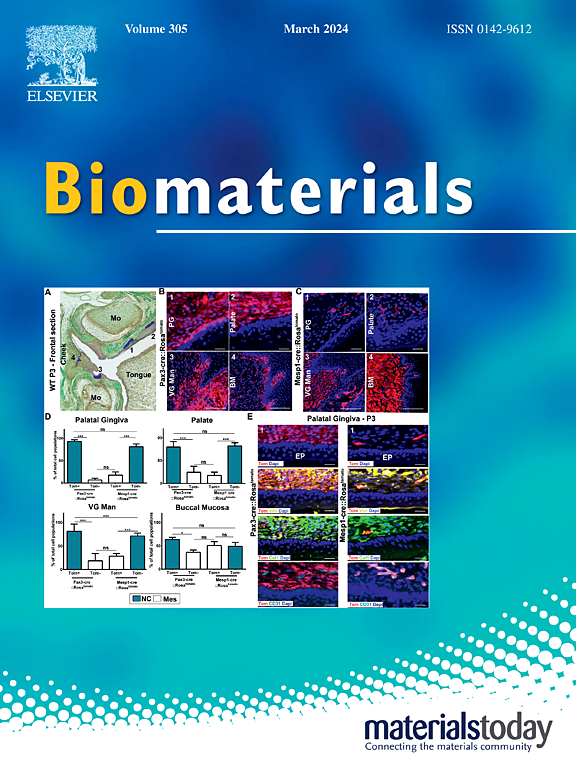Metal ion coordinated tea polyphenol nanocoating for enhanced probiotic therapy in inflammatory bowel disease
IF 12.8
1区 医学
Q1 ENGINEERING, BIOMEDICAL
引用次数: 0
Abstract
Probiotics encapsulated with metal-phenolic networks (MPNs) present a promising approach for treating inflammatory bowel diseases (IBD). However, current MPN systems predominantly use tannic acid (TA) as the phenolic source, with limited exploration of other polyphenols, and face challenges in long-term stability and biocompatibility. Herein, three alternative tea polyphenols, gallic acid (GA), epigallocatechin (EGC) and epigallocatechin gallate (EGCG), were coordinated with ferric ions, to fabricate MPN-coated Lactobacillus rhamnosus LGG (MPN@L). These were compared with TA-based MPN@L to evaluate their effectiveness in alleviating IBD. All MPN@L complexes demonstrated superior adhesion and retention compared to uncoated probiotics in both ex vivo and in vivo models. Specifically, EGC@L exhibited the highest survival rate throughout gastrointestinal digestion, with a 2.7 log CFU/mL improvement over uncoated probiotics, and showed optimal retention in murine intestine with a fluorescence intensity of 24.3 × 106 p/s/cm2/sr by day four. All MPN@L formation effectively alleviated ulcerative colitis by reducing myeloperoxidase levels, modulating cytokines profiles, and enhancing gut microbiota. EGC@L particularly increased beneficial bacterial genera, including Lactobacillus, Adlercreutzia, and Oscillospira, while decreasing the pro-inflammatory genera. This study highlights the potential of MPN-based probiotic microencapsulation to enhanced treatment for gastrointestinal disorders, expending the application of probiotic microencapsulation in IBD therapy.
金属离子配位茶多酚纳米涂层增强益生菌治疗炎症性肠病
金属酚网络(mpn)包裹的益生菌是治疗炎症性肠病(IBD)的一种很有前途的方法。然而,目前的MPN系统主要使用单宁酸(TA)作为酚源,对其他多酚的探索有限,并且在长期稳定性和生物相容性方面面临挑战。本文将三种替代茶多酚,没食子酸(GA)、没食子儿茶素(EGC)和没食子儿茶素没食子酸酯(EGCG)与铁离子配合,制备了mpn包被的鼠李糖乳杆菌LGG (MPN@L)。将这些与基于ta的MPN@L进行比较,以评估其缓解IBD的有效性。在离体和体内模型中,与未包被的益生菌相比,所有MPN@L复合物都表现出优越的粘附性和保留性。具体来说,EGC@L在整个胃肠道消化过程中表现出最高的存活率,比未包被的益生菌提高了2.7 log CFU/mL,并且在小鼠肠道中表现出最佳滞留,第四天的荧光强度为24.3 × 106 p/s/cm2/sr。所有MPN@L形成有效减轻溃疡性结肠炎通过降低髓过氧化物酶水平,调节细胞因子谱,增强肠道微生物群。EGC@L特别增加了有益菌属,包括乳酸杆菌,阿德勒克氏菌和示波螺旋菌,同时减少了促炎菌属。本研究强调了基于mpn的益生菌微胶囊在增强胃肠道疾病治疗方面的潜力,扩大了益生菌微胶囊在IBD治疗中的应用。
本文章由计算机程序翻译,如有差异,请以英文原文为准。
求助全文
约1分钟内获得全文
求助全文
来源期刊

Biomaterials
工程技术-材料科学:生物材料
CiteScore
26.00
自引率
2.90%
发文量
565
审稿时长
46 days
期刊介绍:
Biomaterials is an international journal covering the science and clinical application of biomaterials. A biomaterial is now defined as a substance that has been engineered to take a form which, alone or as part of a complex system, is used to direct, by control of interactions with components of living systems, the course of any therapeutic or diagnostic procedure. It is the aim of the journal to provide a peer-reviewed forum for the publication of original papers and authoritative review and opinion papers dealing with the most important issues facing the use of biomaterials in clinical practice. The scope of the journal covers the wide range of physical, biological and chemical sciences that underpin the design of biomaterials and the clinical disciplines in which they are used. These sciences include polymer synthesis and characterization, drug and gene vector design, the biology of the host response, immunology and toxicology and self assembly at the nanoscale. Clinical applications include the therapies of medical technology and regenerative medicine in all clinical disciplines, and diagnostic systems that reply on innovative contrast and sensing agents. The journal is relevant to areas such as cancer diagnosis and therapy, implantable devices, drug delivery systems, gene vectors, bionanotechnology and tissue engineering.
 求助内容:
求助内容: 应助结果提醒方式:
应助结果提醒方式:


